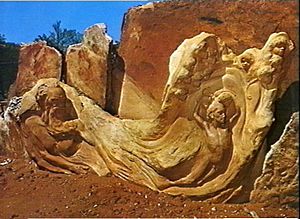Pitchi Richi Sanctuary facts for kids
Pitchi Richi Sanctuary is a special place located about 4 kilometers south of Alice Springs. It was a popular tourist spot that opened in the early 1950s, created by a man named Leo Corbet. The sanctuary is most famous for its amazing collection of sculptures by William Ricketts. It has the largest collection of his works outside of Ricketts' own sanctuary in Victoria.
Pitchi Richi was Alice Springs' very first tourist attraction made by people. In the 1960s, it was even called one of the top four "must-see" places in the region!
The Story of Pitchi Richi
The Pitchi Richi Sanctuary is located just south of Heavitree Gap. Leo Corbet bought the 12 acres of land in 1955. Before him, the land belonged to an interesting Alice Springs character named Charles 'Pop' Chapman, who called his property 'The Pearly Gates'.
It's not exactly known when Corbet changed the name to Pitchi Richi. He once told a friend that 'The Pearly Gates' might sound "a bit presumptuous" coming from him! The name Pitchi Richi comes from the Arrernte language. It roughly means "come and look" or "gap in the range." William Ricketts, who was a good friend of Corbet's, built a special oven (called a kiln) on the site soon after it was bought. His beautiful sculptures were shown there from the very beginning.
An Open-Air Museum
Leo Corbet wanted the sanctuary to be like an open-air museum. He traveled a lot to collect old items from Central Australia. People say he was very charming, which helped him get permission to look through old sheds and rubbish dumps on many faraway stations. This helped Corbet create a really interesting collection.
Besides the art, the sanctuary also had spear and boomerang throwing shows. Corbet also worked to make it a bird sanctuary, which made it very popular with visitors.
When Pitchi Richi opened in August 1956, it hosted an art show by a landscape artist named Robert Johnson. The money raised from this show went to the Australian Inland Mission. In the same year, they also held pottery workshops with a ceramic artist named Roy Cook.
National Attention
In 1958, a magazine called Woman's Day wrote a big article about the sanctuary. The writer, Ailsa Craig, described it as a peaceful place. She wrote that Leo Corbet had made his childhood dream come true. She said it was a place where making money wasn't important, and where he could live simply and help people just for the sake of helping them.
She also said Pitchi Richi was a place where anyone could drop in, even if Corbet wasn't home. There were always things ready to make tea and biscuits. After this article, Corbet and the sanctuary became famous across Australia. Ailsa Craig even sent him a huge kettle because his old one wasn't big enough!
It is also said that the famous artist Albert Namatjira sometimes camped at the site.
Pitchi Richi Today
The sanctuary closed in the 1970s. Since then, the Ricketts' sculptures have faced some challenges. They have been damaged and some attempts to fix them haven't worked well. There have also been different ideas about how the sculptures show Aboriginal people. Who exactly owns the William Ricketts sculptures at Pitchi Richi has been a topic of discussion since the early 1960s.
Pitchi Richi was added to the Northern Territory Heritage Register in 2009. This means it is recognized as an important historical place. Today, it is looked after by Heritage Alice Springs Inc. and cared for by caretakers. It is sometimes open for special public events and groups can visit by making an appointment.


